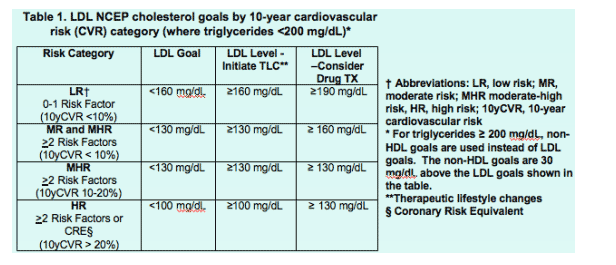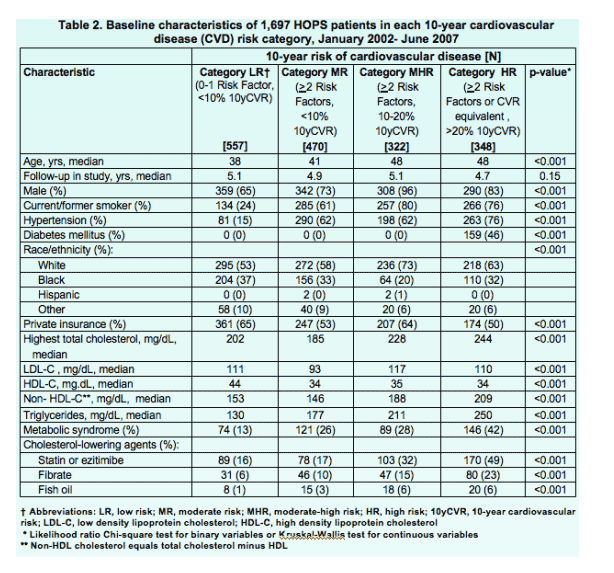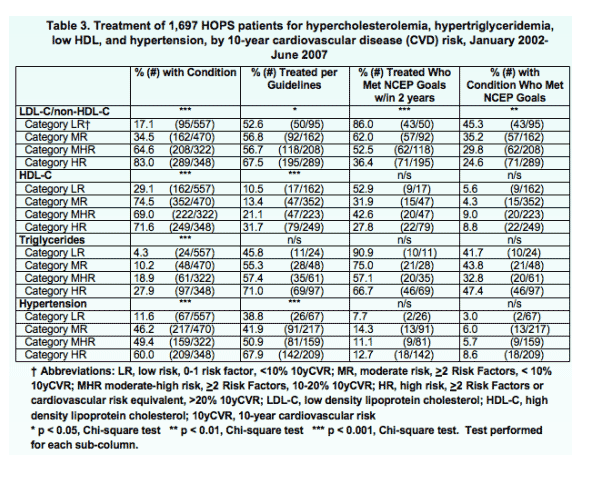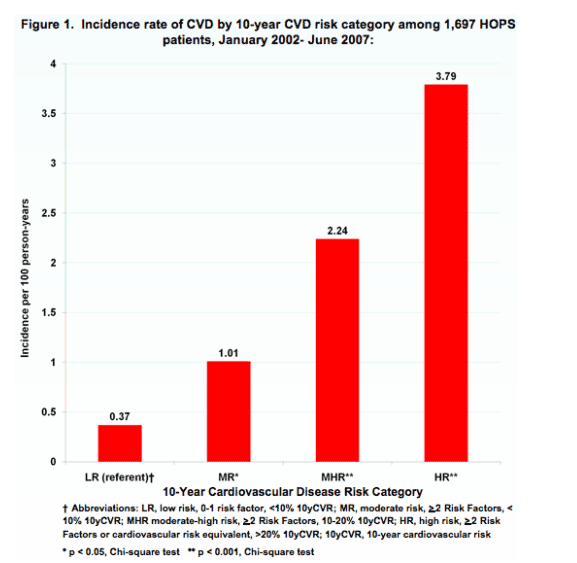 |
 |
 |
| |
(NCEP)-based IDSA/ACTG Guidelines for Management of Cardiovascular Risk in the HIV Outpatient Study (HOPS)
|
| |
| |
Reported by Jules Levin
IAC Mexico City Aug 3-8 2008
KA Lichtenstein1, K Buckner1, C Armon2, EM Tedaldi3, JS Chmiel4,
KC Wood2, K Buchacz5, SD Holmberg5, JT Brooks5,
and the HOPS Investigators
1National Jewish Health, Denver, CO; 2Cerner Corporation, Vienna, VA; 3Temple University, Philadelphia, PA; 4Northwestern University, Chicago, IL; 5Centers for Disease Control and Prevention, Atlanta, GA
ABSTRACT
Background: Compliance with NCEP-based IDSA/ACTG guidelines reduces risk of cardiovascular disease (CVD) in the general population.
Methods: We categorized HOPS participants into the four 10-year cardiovascular disease risk (10yCVR) strata (Table 1) as defined in NCEP guidelines. We included patients active after 1/1/02 with ≥2 office visits, ≥2 blood pressure readings and ≥1 lipid panel measured ) within -12/+9 months from first visit after 1/1/02 (baseline). We followed patients until 6/30/07, death, or last office visit and calculated rates of incident CVD events (i.e. myocardial infarction, coronary artery disease, peripheral vascular disease, transient ischemic attack, angina, aortic aneurysm, coronary artery bypass, or angioplasty). We examined trends in the fraction of guideline-eligible patients treated for dislipidemia and hypertension, and in the incidence of CVD during the two years after baseline using the Cochrane-Armitage test for trend.
Results: Of 1,697 patients with sufficient data for analysis, 557 (32.8%) had < 2 CVD risk factors (Lower Risk = LR). In patients with >2 risk factors, 10yCVR was <10% (Moderate Risk = MR) for 470 (27.7%) patients, 10-20% (Moderately High Risk = MHR) in 322 (19.0%), and >20% (High Risk = HR) in 348 (20.5%) (Table 2). For subjects in each risk category the percent of individuals with low density lipoprotein/non-high density lipoprotein (LCL-C/non-HDL-C), triglycerides, and hypertension that exceeded goals or HDL-C below goal increased with increasing risk category (Table 3). Compliance with NCEP treatment guidelines increased with increasing risk. However, among patients treated for LDL-C/non-HDL-C according to the guidelines, a decreasing percentage achieved target goals with each successive higher risk category. For the HDL-C, triglycerides, and hypertension goals, there was no significant difference between the risk groups. Incidence of CVD increased with increasing risk category (Figure 1).
Conclusions: At least one-fifth of contemporary HOPS patients have a 10yCVR >20%. Despite a high frequency of clinical encounters and higher compliance with NCEP guidelines with increasing cardiovascular risk, achievement of treatment goals fell with successively higher cardiovascular risk. These findings highlight the challenge clinicians and patients face modifying major cardiovascular disease risk factors in the HIV-infected population.




|
| |
|
 |
 |
|
|